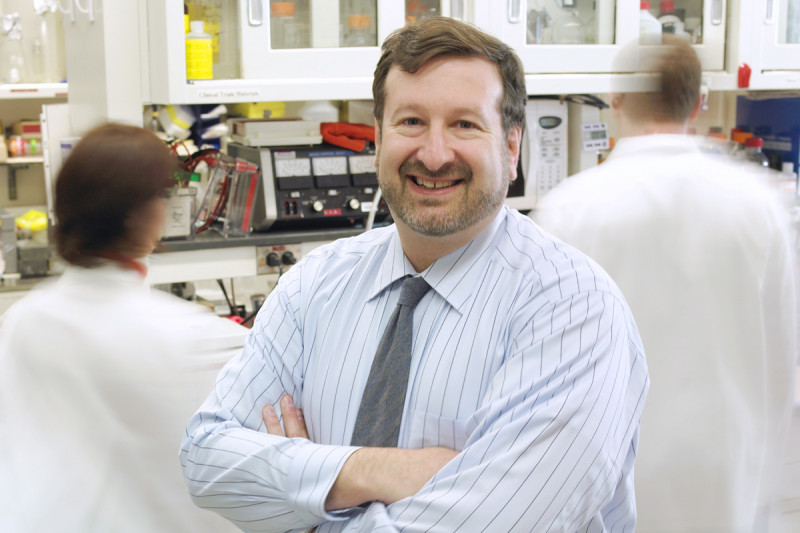
David Scheinberg, Chairman, Molecular Pharmacology and Chemistry Program
David Scheinberg is an internationally recognized leader in the development of targeted immunotherapies and an important mentor for young scientists. We spoke with him in 2005.
My father, a physician-scientist, first introduced me to medicine and science. When I was a child, he once brought home mice with tumors caused by cigarette carcinogens rubbed into their skin. Sometimes he would take me on rounds in the hospital too. Toward the end of college, I felt driven to get my own research going. I skipped a year of college, a year of graduate school, a year of medical school, and a year of residency in order to start my own lab as quickly as possible.
During college I worked nights and weekends at the Cornell Veterinary College, studying cat leukemia viruses. Summers, I worked in a laboratory at Albert Einstein College of Medicine studying retroviruses. The mid-1970s were an exciting time because we thought that the understanding of retroviruses might rapidly lead us to the causes of cancer.
A few years later, key discoveries about how to make monoclonal antibodies led me to think about merging these two fields of study. Antibodies would soon become remarkable tools for understanding the biology of cancer and for treatment. At that time, we thought monoclonal antibodies would be the “magic bullets” for cancer, but in fact it would be many years before they became truly important drugs.
When the lab in which I was working during college moved to Johns Hopkins Medical School, the lab director asked me to leave college and join him in Baltimore. I did so and later joined the MD-PhD program there. Coincidentally, in 1977 Tom Kelly [who later served as Director of Sloan Kettering Institute] taught me in one of my first courses there. Those years greatly influenced my research directions to this time.
Looking for Novel Therapeutic Approaches
I always had the goal, even back then, of developing novel therapeutic approaches. The novelty was especially important to me. I’ve tried to do things that other scientists are not working on. I did not want to be part of a large crowd of investigators moving in the same direction. This is still reflected in what I do now.
In 1982, I applied for a job at Memorial Sloan Kettering because I saw it as one of the few places in the world where I could apply my laboratory work directly to my work in the hospital. In my view, the Center remains the best place in the world to do bench-to-bedside translation of therapeutics. Memorial Sloan Kettering Cancer Center has an infrastructure and a culture of investigation that allows physician-scientists to do experiments and trials that could not be done anywhere else.
Everything we work on in my lab is part of a strategy for cancer therapy. I encourage the clinical investigators to attend my lab meetings so that there is a lot of interaction between bench scientists and clinicians. This provides better understanding on both sides, as well as a lot of motivation as we see that what we’re working on at the bench is going to help people directly.
As a physician, I’ve spent more than 20 years caring for patients with cancer. From 1992 to 2003, I was Chief of Memorial Sloan Kettering Cancer Center’s Leukemia Service, where our focus was on developing new therapies. The Service provided a great platform for testing new therapeutic ideas, many of which were quite successful. During that time the Service developed retinoic acid and arsenic trioxide as treatments for promyelocytic leukemia, and conducted the first studies in patients with leukemia using humanized antibodies, oncogene vaccines, and alpha- and beta-particle radioimmunotherapy.
Recently we developed a sophisticated agent known as an in vivo generator, or nanogenerator, which we can attach to an antibody and deliver into patients intravenously. This nanogenerator produces radioactive isotopes directly on or within cancer cells. It appears to be 1,000 times more potent than our original radiolabeled drugs. This new approach was approved for testing in humans by the FDA at the end of May.
Creation of the Center for Experimental Therapeutics
One advantage of developing new therapeutics at an academic center like Memorial Sloan Kettering is that it allows us to test ideas that are unlikely to be tackled by a pharmaceutical company. The creation of the Center for Experimental Therapeutics in 2002 was a coalescence of diverse functions of Memorial Sloan Kettering investigators. The center gives investigators the freedom to discover and test novel, cutting-edge ideas that may ultimately become therapeutics. I believe these concepts will form the basis for the next generation of treatments.
Our model is a seamless pathway — from discovering and synthesizing molecules to characterizing and testing them in vitro, and then in animals, to eventually treating patients. Our key idea behind the center is that if we bring together the smartest people from divergent scientific disciplines, they will more rapidly accomplish goals and make discoveries. The center includes chemists, molecular biologists, medical oncologists, radiation oncologists, structural biologists, radiologists, immunologists, and others — all working to understand how to make drugs work better.
The Search for Targeted Therapies
The field of experimental cancer therapy is constantly being fueled by biological discoveries, including new knowledge about the genetic changes that lead to the formation of cancer. We are increasingly focusing on the exact pathways, proteins, and mutations that cause cancer.
Traditionally, treatments were relatively nonspecific, but now there is an enormous opportunity to make more selective, and therefore safer, therapies. This will lead to an era of personalized cancer medicine in which small molecules that target enzymes, monoclonal antibodies that target surface proteins, and vaccines that target internal proteins can be designed for the individual pathways that cause different cancers.
At Memorial Sloan Kettering, we can combine multiple therapeutic strategies — for instance, chemotherapy with immuno-therapy and differentiating agents — to come up with a better result. We have immunologists working with pharmacologists, transplantation experts, and radiation oncologists to develop therapies that attack cancer from several different angles in order to find the best treatments possible.


